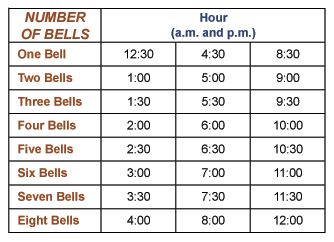(Click any question to see the answer)
My clock is gaining (or losing) time. Which way do I turn the nut at the bottom of the pendulum?
I took the weights off my grandfather clock to move it and forget which way they go back on. Is there a correct order?
Yes, the order is critical for proper function. On 99% of floor clocks (grandfather/grandmother) with three weights, the heavier weight goes on the right-hand chain hook or pulley as you are FACING the clock. Many weights are marked on the bottom with “Left”, “Center”, or “Right”, or sometimes with just “L”, “C”, “R”. Occasionally only the Right weight will be marked, often with only an “X”, dot or dimple. Some movement manufacturers used one lighter weight and two heavier (but equal) weights. The two heavier weights go on the center and right hooks or pulleys.
For floor clocks with only two weights, the heavier weight USUALLY goes on the right side, but this varies widely, especially on clocks older than 50 years. If the clock runs but won’t strike, try reversing the weights.
The rules are the same for weight driven wall clocks.
Are a “cleaning” and “overhaul” the same thing or separate procedures?
“Cleaning” is only one part of the entire process of the “overhaul.” When a clock is overhauled, it must be disassembled and cleaned before any re-machining or bushing work is done. Even in the rare instance where a clock doesn’t require any re-machining of parts or new bushings after cleaning, we still use the term “overhaul” because of the other aspects of the work such as lubrication, linkage adjustment, calibration, etc, that is integral to the process.
How often should my clock be oiled?
All mechanical clocks should be oiled every 2-3 years and we strongly advise you take your clock to a professional. He or she will use the correct lubricant and will know exactly where to oil, and just as importantly, where NOT to oil. A professional “oiling” involves more than just applying special lubricants in the right places. Most clock smiths will also make minor adjustments to linkages, chime and strike functions, electronically regulate the clock and set the “beat”.
How often should my clock be cleaned (overhauled)?
As a rule of thumb, if you have your clock professionally oiled every 2 or 3 years as recommended, it should only require a complete overhaul about every 10 to 12 years. However, I have seen some clocks malfunction from wear within 6 years (even with regular oiling), and I have seen some that were over 20 years old that showed very little wear at all. Don’t assume that a correctly running clock isn’t in need of some degree of professional service. It could be just a matter of time (no pun intended) before it fails in some way. An inspection by a professional clocksmith is always a good idea, and he or she can advise you if an overhaul is needed. Ask your clocksmith for his recommendations the next time you have your clock oiled.
My clock doesn’t strike the correct number of times. How do I fix this?
This can happen for a variety of reasons, but most often the hour (shorter) hand gets out of alignment with the internal strike mechanism (usually from being bumped when setting the time, or the clock was allowed to run down). Usually, the hour hand can be easily adjusted by gently rotating it so that it points to the correct position. For example if the clock just struck four times then move the hour hand to point to the numeral four. Now you must reset the clock to the correct time by turning only the MINUTE (longer) hand. Some clocks can be set by turning the minute hand counterclockwise. If you don’t know, then it is always safer to turn the minute hand clockwise. Also, without knowing the type of clock you have, it is best to stop and let it chime or strike at each point so it stays in synch. Some antique clocks have a “trip-wire” that allows you to repeatedly activate the strike to bring it into synch with what the hands display.
What is “Ship’s Bell time and what is the significance?
Sailors aboard ship would be assigned one of six (sometimes seven) separate duty watches. Beginning with 1 bell at 12:30 am (0030 hours) each subsequent half-hour was announced by an additional bell, up to a maximum of eight. Two, distinct watch/count systems were employed depending on whether the night crew was split into two “dog watches” instead of one.
This is the classical system:
This is the simpler system we are accustomed to hearing on most household ship’s clocks:
The weights on my grandfather clock aren’t coming down evenly. The center weight appears to be dropping faster than the other two. What’s going on?
This may be normal if your clock has a chime silencing feature. If you position the chime selector lever to silent or automatic nighttime silence (if equipped), that part of the mechanism is temporarily inoperable. The left and right weights will not descend. Only the center weight (which powers the hands and pendulum) will descend, giving the appearance that it is coming down faster than the others.
If your clock is not silenced, or doesn’t have that feature, check to see that the weights are hanging on the correct chains or pulleys. The heavier weight should be on the right hand side as you face the clock.


